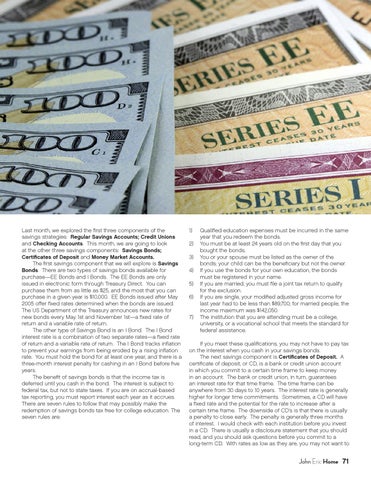Last month, we explored the first three components of the savings strategies: Regular Savings Accounts; Credit Unions and Checking Accounts. This month, we are going to look at the other three savings components: Savings Bonds; Certificates of Deposit and Money Market Accounts. The first savings component that we will explore is Savings Bonds. There are two types of savings bonds available for purchase—EE Bonds and I Bonds. The EE Bonds are only issued in electronic form through Treasury Direct. You can purchase them from as little as $25, and the most that you can purchase in a given year is $10,000. EE Bonds issued after May 2005 offer fixed rates determined when the bonds are issued. The US Department of the Treasury announces new rates for new bonds every May 1st and November 1st—a fixed rate of return and a variable rate of return. The other type of Savings Bond is an I Bond. The I Bond interest rate is a combination of two separate rates—a fixed rate of return and a variable rate of return. The I Bond tracks inflation to prevent your earnings from being eroded by a rising inflation rate. You must hold the bond for at least one year, and there is a three-month interest penalty for cashing in an I Bond before five years. The benefit of savings bonds is that the income tax is deferred until you cash in the bond. The interest is subject to federal tax, but not to state taxes. If you are on accrual-based tax reporting, you must report interest each year as it accrues. There are seven rules to follow that may possibly make the redemption of savings bonds tax free for college education. The seven rules are:
1) Qualified education expenses must be incurred in the same year that you redeem the bonds. 2) You must be at least 24 years old on the first day that you bought the bonds. 3) You or your spouse must be listed as the owner of the bonds; your child can be the beneficiary but not the owner. 4) If you use the bonds for your own education, the bonds must be registered in your name. 5) If you are married, you must file a joint tax return to qualify for the exclusion. 6) If you are single, your modified adjusted gross income for last year had to be less than $89,700; for married people, the income maximum was $142,050. 7) The institution that you are attending must be a college, university, or a vocational school that meets the standard for federal assistance. If you meet these qualifications, you may not have to pay tax on the interest when you cash in your savings bonds. The next savings component is Certificates of Deposit. A certificate of deposit, or CD, is a bank or credit union account in which you commit to a certain time frame to keep money in an account. The bank or credit union, in turn, guarantees an interest rate for that time frame. The time frame can be anywhere from 30 days to 10 years. The interest rate is generally higher for longer time commitments. Sometimes, a CD will have a fixed rate and the potential for the rate to increase after a certain time frame. The downside of CD's is that there is usually a penalty to close early. The penalty is generally three months of interest. I would check with each institution before you invest in a CD. There is usually a disclosure statement that you should read, and you should ask questions before you commit to a long-term CD. With rates as low as they are, you may not want to
John Eric Home 71
